Italian All-in-One For Dummies (65 page)
Read Italian All-in-One For Dummies Online
Authors: Consumer Dummies

Going farther south, you find examples of the 20th-century, eclectic architectural style in Palermo, a city in the island region of Sicily, including the
Palazzina Cinese
(
Chinese Palace
), the
Ginnasio dell'Orto botanico
(
Gymnasium of the Botanical Garden
), and the late
Teatro Massimo
(
Massimo Theater
). Echoes of this style can be found in North Italy in the Piedmont region, including the
Mole Antonelliana
in Turin and the
Basilica of San Gaudenzio
(
St. Gaudenzio Cathedral
) in Novara. In the region of Lombardy, not too far from Piedmont, you won't want to miss the
Galleria Vittorio Emanuele II
(
Victory Emanuel II Gallery
) in Milan, which, along with
Via Montenapoleone
and
Via della Spiga,
is considered the heart of
acquisti di lusso
(ah-
kwee
-stee dee
loohs
-soh) (
luxury shopping
) in North Italy. In Southern Italy, in the city of San Giovanni Rotondo, be sure to visit the
Convento Santuario di Padre Pio
(
Monastery and Sanctuary of Padre Pio
) by Renzo Piano, who also designed the
Stadio San Nicola
(
St. Nicolas Stadium
) in the city of Bari. Returning to Naples, the
Museo della Stazione Metropolitana
(
Museum Subway Station
) designed by Gae Aulenti is well worth a visit.
Finding the places you're looking for
When you're searching for a specific place, sentences like these can help you ask the right questions:
Mi sa dire dov'è la stazione?
(mee sah
dee
-reh doh-
veh
lah stah-
tsyoh
-neh?) (
Can you tell me where the station is?
)
Devo andare all'aeroporto.
Quale strada devo prendere?
(
deh
-voh ahn-
dah
-reh
ahl
-lah-eh-roh-
pohr
-toh.
kwah
-leh
strah
-dah
deh
-voh
prehn
-deh-reh?) (
I have to go to the airport. What road should I take?
)
Sto cercando il teatro Valle.
(stoh chehr-
kahn
-doh eel teh-
ah
-troh
vahl
-leh.) (
I'm looking for the Valle theater.
)
Dov'è il cinema Astoria, per favore?
(doh-
veh
eel
chee
-neh-mah ah-
stoh
-ryah, pehr fah-
voh
-reh?) (
Where is the Astoria cinema, please?
)
Come posso arrivare al Museo Etrusco?
(
koh
-meh
pohs
-soh ahr-ree-
vah
-reh ahl mooh-
zeh
-oh eh-
trooh
-skoh?) (
How can I get to the Etruscan Museum?
)
La strada migliore per il centro, per favore?
(lah
strah
-dah mee-
lyoh
-reh pehr eel
chehn
-troh, pehr fah-
voh
-reh?) (
The best way to downtown, please?
)
Che chiesa è questa?
(keh
kyeh
-zah
eh
kwehs
-tah?) (
What church is this?
)
Quale autobus va all'ospedale?
(
kwah-
leh
ou
-toh-boohs vah ahl-lohs-peh-
dah
-leh?) (
Which bus goes to the hospital?
)
Come faccio ad arrivare all'università ?
(
koh
-meh
fach
-choh ahd ahr-ree-
vah
-reh ahl-
looh-
nee-vehr-see-
tah?
) (
How can I get to the university?
)

 Â The evolution of Italian architecture
 The evolution of Italian architecture
Early Italian
architettura
(ahr-kee-teht-
tooh
-rah) (
architecture
) was strongly influenced by Etruscan and Greek culture. Later, with the advent of the Roman Empire, it began to develop original features, particularly its use of
archi
(
ahr
-kee) (
arches
),
volte
(
vohl-
teh) (
vaults
), and
cupole
(
kooh
-poh-leh) (
domes
). Important examples are
i bagni
(ee
bah
-nyee) (
baths
) (
Terme di Caracalla,
Terme di Diocleziano
),
gli anfiteatri
(lyee ahn-fee-teh-
ah
-tree) (
amphitheaters
) (
Colosseum, Arena di Verona
),
i
teatri
(ee teh-
ah
-tree) (
theaters
) (
Teatro di Marcello
),
le
chiese
(leh
kyeh
-seh) (
churches
) (such as the
Basilica di Massenzio
), and
i
Â
templi
(ee
tehm
-plee) (
temples
) (
Pantheon
).
From the Christian and Byzantine era to the
Medioevo
(meh-dyoh-
eh
-voh) (
Middle Ages
), the architectural context was predominantly ecclesiastical and
religioso
(reh-lee-
joh
-soh) (
religious
). In the Middle Ages,
l'architetto
(lahr'kee-
teht
-toh) (
the architect
) was a master craftsman who, after years of experience, supervised the design of the building and the development of the project. In the “Humanist” period that followed the Middle Ages, the architect became more of an artist and less of a craftsman.
During the Renaissance, Italy developed an entirely new way of looking at architecture. Leon Battista Alberti developed the concept of the
città ideale
(cheet-
tah
ee-deh-
ah
-leh) (
ideal city
)
.
Now, for the first time, architecture became concerned with the idea of planning an ideal city with the proper arrangement of its elements.
Lo stile barocco
(loh
stee
-leh bah-
rohk
-koh) (
the Baroque style
), linked to the Counter-Reformation, was developed in Rome and exercised its influence throughout the Catholic world. The first examples of this style are found in works (mostly religious) by Carlo Maderno, Gian Lorenzo Bernini, Francesco Borromini, and Pietro da Cortona. They introduced new shapes into architectural design, such as
ellissi
(ehl-
lees
-see) (
ellipses
),
spirali
(spee-
rah
-lee) (
spirals
), and
curve policentriche
(
koohr
-veh poh-lee-
chehn
-tree-keh) (
polycentric curves
), thus elaborating and modifying the concept of space. The Baroque style soon spread beyond the borders of Rome to the rest of Italy.
The 1800s, the “eclectic” century, saw the reemergence of many past architectural styles, including neo-Renaissance, neo-Baroque, neo-Romanesque, and neo-Gothic styles, as well as later echoes of the Imperial style. The 20th century finally brought some novelty: from art nouveau to the completely new language proposed by Antonio di Sant'Elia in his 1914
Manifesto of Futurist Architecture
and from rationalism to the works of the new, emerging architects â Luigi Moretti, Carlo Scarpa, Franco Albini, Gio Ponti, Tomaso Buzzi, and Pier Luigi Nervi. Currently, the Italian architectural landscape claims Renzo Piano, architect of international fame, as its foremost representative.
Chapter 2
Having Fun Out on the Town
In This Chapter
 Enjoying movies, art, theater, and other forms of entertainment
Enjoying movies, art, theater, and other forms of entertainment
 Giving and receiving invitations
Giving and receiving invitations
G
oing out on the town is always fun. In general, Italians are sociable people who enjoy having a good time. You see them having espressos together
al bar
(ahl bahr) (
in the bar
) or drinks at night
in
piazza
(
een
pyaht
-tsah) (
on the public square
). Most Italians love to go out in the evening, crowding the streets until late at night.
Italy is a popular vacation destination, and Italian cities have a great variety of cultural offerings, from the numerous local fairs and
sagre
(
sah
-greh) (
town celebrations relating to harvest, wild boar, or saint
s
,
for example
) to open-air festivals and music events to city-wide celebrations. The variety is endless, and fun is guaranteed. The festivals relating to saints are for the
santo patrono
(
sahn
-toh pah-
troh
-noh) (
patron saint
). The
sagre
are to celebrate agricultural products. These two things are different.
In this chapter, I give you a lot of information you need to take in cultural attractions and socialize.
Experiencing Italian Culture
No matter where you live or where you travel, most major cities have a weekly
pubblicazione
(poohb-blee-kah-
tsyoh
-neh) (
publication
), listing information about upcoming events. These publications include dates, descriptions, and time schedules for theaters, exhibitions, festivals, films, and so on. They also provide tips for shopping and restaurants.
 In smaller towns without weekly magazines, you may see events announced on posters. You can also find information in the local newspapers.
In smaller towns without weekly magazines, you may see events announced on posters. You can also find information in the local newspapers.
Of course, newspapers aren't your only source of information about things to do and see. Asking the following questions can get you answers you want.
Cosa c'è da fare di sera?
(
koh
-zah cheh dah
fah
-reh dee
seh
-rah?) (
Are there any events in the evenings?
)
Può suggerirmi qualcosa?
(pwoh soohj-jeh-
reer
-mee kwahl-
koh
-zah?) (
Can you recommend something to me?
)
C'è un concerto stasera?
(cheh oohn kohn-
chehr
-toh stah-
seh
-rah?) (
Is there a concert tonight?
)
Ci sono ancora posti?
(chee
soh
-noh ahn-
koh
-rah
pohs
-tee?) (
Are there any seats left?
)
Dove si comprano i biglietti?
(
doh
-veh see
kohm
-prah-noh ee bee-
lyeht
-tee?) (
Where can we get tickets?
)
Quanto vengono i biglietti?
(
kwahn
-toh
vehn
-goh-noh ee bee-
lyeht
-tee?) (
How much are the tickets?
)
A che ora comincia lo spettacolo?
(ah keh
oh
-rah koh-
meen
-chah loh speht-
tah
-koh-loh?) (
What time does the show begin?
)
Non c'è niente di più economico?
(nohn cheh
nyehn
-teh dee
pyooh
eh-koh-
noh
-mee-koh?) (
Isn't there anything cheaper?
)
Talkin' the Talk
Arturo works at a theater. He is bombarded with questions from patrons before the show.
Sig. Paoli:
Quando comincia lo spettacolo?
kwahn
-doh koh-
meen
-chah loh speht-
tah
-koh-loh?
When does the show start?
Arturo:
Alle sette e mezza.
ahl
-leh
seht
-teh eh
mehd
-dzah.
At half past seven.
Erika:
A che ora finisce lo spettacolo?
ah keh
oh
-rah fee-
nee
-sheh loh speht-
tah
-koh-loh?
What time is the show going to end?
Arturo:
Verso le dieci
.
vehr
-soh leh
dyeh
-chee
About 10 p.m.
Erika:
C'è un intervallo?
cheh oohn een-tehr-
vahl
-loh?
Is there an intermission?
Arturo:
Sì, tra il secondo e il terzo atto.
see, trah eel seh-
kohn
-doh eh eel
tehr
-tsoh
aht
-toh.
Yes, between the second and third acts.
Â

Taking in a movie
Going
al cinema
(ahl
chee
-neh-mah) (
to the movies
) is a popular activity almost everywhere. In Italy, American films usually are
doppiati
(dohp-
pyah
-tee) (
dubbed
) into Italian. On the other hand, why not go to an original Italian film? Doing so provides you with a good opportunity to polish your Italian.
Some special questions for the movies include
 Andiamo al cinema?
Andiamo al cinema?
(ahn-
dyah
-moh ahl
chee
-neh-mah?) (
Shall we go to the movies?
)
 Cosa danno?
Cosa danno?
(
koh
-zah
dahn
-noh?) (
What's playing?
)
 Dove lo danno?
Dove lo danno?
(
doh
-veh loh
dahn
-noh) (
Where is [the movie] being shown?
)
 Ã in lingua
à in lingua
(versione) originale?
(eh in
leen
-gwah [vehr-
syoh
-neh] oh-ree-jee-
nah
-leh?) (
Is the film in the original language?
)
